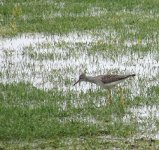Thanks for all the replies. I'm glad that it is not a Greater Yellowlegs. I say that because I want to get to the point where I am confident about separating the two. If it turned out to be a greater, I would be more confused.-I can recall how aggressively the greaters moved and stalked and lunged for their food-The lesser was much more casual in its feeding. They still moved around but in a more casual manner. Now that I went back to find the picture of the greater which I took earlier in the spring, I can see a big difference between the two.-Here are comparison photos.
The one on the left clearly seems heavier bodied and longer billed indicating a Greater Yellowlegs. The one on the right does seem leaner and shorter billed than the one on the right -so Lesser Yellowlegs would make sense to me.-It seems that when I see a Greater Yellowlegs I am pretty certain of it.-When I see a lesser is when the confusion seems to set in.-
It reminds me of when I first started birding and wasn't sure of the difference between a Downy and a Hairy Woodpecker.-When I saw a downy, I might wonder if it was a hairy but when I actually saw a Hairy WP-it seemed so obvious.
edit-Tero-That was funny that you came up with the example of the Downy versus Hairy just before I had a chance to post it myself!
The one on the left clearly seems heavier bodied and longer billed indicating a Greater Yellowlegs. The one on the right does seem leaner and shorter billed than the one on the right -so Lesser Yellowlegs would make sense to me.-It seems that when I see a Greater Yellowlegs I am pretty certain of it.-When I see a lesser is when the confusion seems to set in.-
It reminds me of when I first started birding and wasn't sure of the difference between a Downy and a Hairy Woodpecker.-When I saw a downy, I might wonder if it was a hairy but when I actually saw a Hairy WP-it seemed so obvious.
edit-Tero-That was funny that you came up with the example of the Downy versus Hairy just before I had a chance to post it myself!
Attachments
Last edited:






